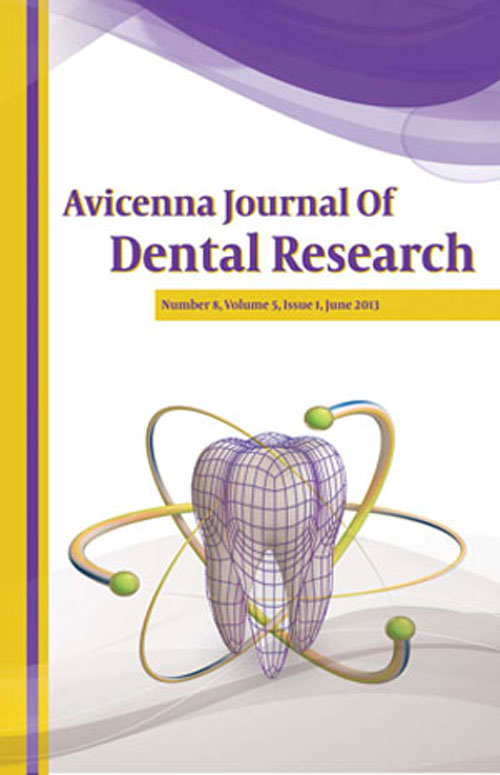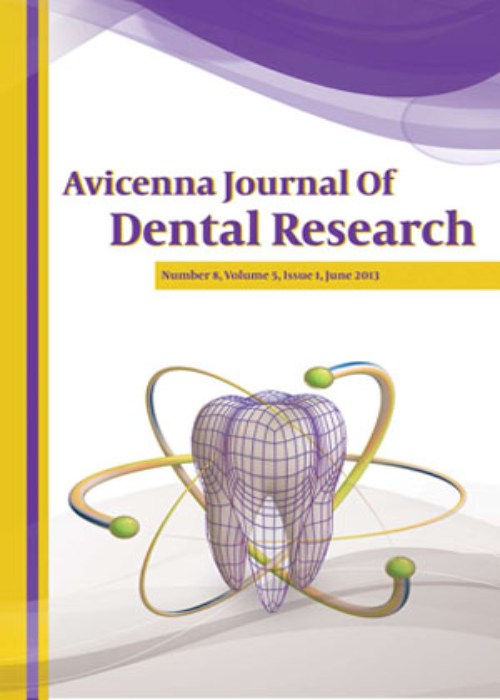فهرست مطالب

Avicenna Journal of Dental Research
Volume:8 Issue: 3, Sep 2016
- تاریخ انتشار: 1395/08/03
- تعداد عناوین: 8
-
-
Page 1BackgroundEndodontic treatment is one of the stress producing situations..ObjectivesThe purpose of this article was to determine the most stressful stage of root canal therapy among endodontists, endodontic residents, and undergraduate dental students and offering some strategies for reducing stress during this treatment..
Patients andMethodsThis descriptive survey comprised three groups. Thirty-six endodontists, 41 endodontic residents, and 47 undergraduate dental students selected by convenience sampling. Participants were asked about age, sex, the most stressful stage of root canal therapy and stress reducing strategies during the procedure..ResultsThe most stressful stage of root canal therapy was endodontic treatment for children in male endodontists and residents, preparing access cavity on crowns in female endodontists, obturation of apically root Resorped canals in female residents, obturation in female students, and preparing access cavity on molar teeth in male students. The most suggested strategy for reducing stress during root canal therapy was related to experience, knowledge, enough study, and technical mastery..ConclusionsIt is required to consider the strategies during student education in dental schools for both under and post-graduation dental students and better to follow them in workshops for other dentists and even endodontists..Keywords: Stress, Student, Dental, Root Canal Therapy -
Page 2BackgroundSuccessful endodontic treatment is dependent on the knowledge of root canal anatomy..ObjectivesThis study aims to investigate the root canal anatomy of mandibular first molars in an Iranian population..Materials And MethodsOne hundred human mandibular first molars were collected and stored in 5.25% NaOCl. Radiographic images of the teeth were taken in mesial, distal, and buccal aspects using digital radiography. The root numbers were recorded, and the teeth were covered with lacquer. Access cavities were prepared, pulp tissue was dissolved, the apex was covered with liquid glue, and the root canals were injected with methylene blue. Decalcification of the teeth meant they were kept in 10% nitric acid, and final dehydration meant they were kept in 100% Isopropyl alcohol for 72 hours and rendered clear by immersion in methyl salicylate. The number of root canals per tooth, the number of canals per root, and canal configuration in each tooth were recorded..ResultsNinety-nine of the 100 teeth had two roots and the other had three roots. The teeth were classified based on the number of canals; there were 2% with two canals, 59% with three canals, and 39% with four canals. Based on the Vertucci classification, the most prevalent canal configurations in the mesial root were types II and IV, and type I in the distal root..ConclusionsThe most common root morphology is the two rooted morphology with three canals. Both the mesial and distal roots show wide variations in canal anatomy with type IV and type I canal configuration predominating in the mesial and distal roots, respectively. Iranian mandibular first molar teeth exhibit features close to the average Caucasian, Jordanian, and Kuwaitis root and canal morphology..Keywords: Mandibular First Molar, Clarification, Root Canal Morphology
-
Page 3ObjectivesThe purpose of this study was to determine the numbers and mean areas of the AgNOR dots in the 3 most common salivary gland tumors..Materials And MethodsOne hundred and seventy paraffin blocks histologically diagnosed as pleomorphic adenoma, adenoid cystic carcinoma, and mucoepidermoid carcinoma were selected from the archives of the pathology department of Loghman hospital, Tehran, Iran and then cut and stained using the standard AgNOR method. The number and area of AgNOR dots were evaluated. Chi-square and Pearson correlation (2-tailed) tests were used for statistical analysis. The significance level was PResultsThe chi-square test showed significant differences between tumor types and the numbers of AgNORs (P = 0.000) and between tumor types and areas of AgNORs (P = 0.000)..ConclusionsThe AgNOR technique can be used to diagnose salivary gland tumors..Keywords: AgNOR Method, Salivary Gland Tumors, Diagnosis
-
Page 4BackgroundLichen planus is a chronic inflammatory mucocutaneous disease that is most commonly found in middle-aged women. A wide spectrum of topical and systemic therapies have been applied for treatment of this condition..ObjectivesThe aim of this study was to compare the efficacy and safety of 1% Glycyrrhiza glabra in orabase with 0.1% Triamcinolone Acetonide paste in treating oral lichen planus (OLP)..
Patients andMethodsIn this study, 22 patients were randomly assigned to one of two equal groups. They received either Glycyrrhiza glabra or Triamcinolone Acetonide four times daily for a total of one month and were followed-up for three months. The patients were assessed for painful symptoms, measured by the visual analogue scale (VAS), and lesion size via Thongaprassom. The analysis and comparison of pain scores and the size of the lesion's clinical and symptomatic response rates between the two groups were performed using the Mann-Whitney U-test and SPSS 13.0 computer software..ResultsTen patients in the Glycyrrhiza glabra group and 12 patients in the triamcinolone acetonid group completed the four-month trial course. Both Glycyrrhiza glabra and Triamcinolone Acetonid reduced burning symptoms. Clinical scores in both groups also significantly improved over the one-month treatment period. The difference between the two groups was not statistically significant (P = 0.442)..ConclusionsThis study showed that topical Glycyrrhiza glabra appeared to be a promising alternative in the treatment of OLP. Further studies should be conducted to assess the long-term effects of Glycyrrhiza glabra..Keywords: Oral Lichen Planus (OLP), Triamcinolone Acetonide, Glycyrrhiza glabra -
Page 5BackgroundAcquiring fine psychomotor skills is challenging for dental students..ObjectivesThis study aimed to assess the correlation of cavity preparation skills with drawing skills and handwriting of dental students..MethodsNinety-two male and female dental students taking the preclinical course of restorative dentistry in Shahid Beheshti dental school participated in three tests of handwriting, drawing a smile and an amalgam class (CL) I cavity preparation and were scored using a specific scoring system. The correlation among the three skills was assessed using multivariate linear regression..ResultsMost dental students had cavity preparation, handwriting and drawing skills above the average. A significant correlation was found between drawing and tooth preparation skills (PConclusionsA statistically significant difference existed between drawing and cavity preparation skills in students; however, this correlation was not clinically considerable..Keywords: Cavity Preparation, Dental Students, Drawing, Handwriting, Psychomotor Skills
-
Page 6BackgroundThe toxicity of the methyl methacrylate monomer is an ongoing concern in dentistry. Therefore, those who are involved with this substance need to be cognizant of how to work with it..ObjectivesThis study aimed to evaluate the level of working knowledge about methyl methacrylate among undergraduate prosthodontics students at Shahid Sadoughi university in 2014..Materials And MethodsIn this descriptive cross-sectional study, the knowledge level of 54 undergraduate prosthodontics students, who had passed the last 2 years of their education, was assessed via a 13-question survey related to methyl methacrylate. Each correct answer was assigned 2 points, and the total sum of right answers was used to measure the knowledge level of each participant. In order to analyze the study data, SPSS16 was used to apply an ANOVA test, t-test, and Pearson correlation coefficient..ResultsThe mean level of individuals knowledge in regard to working with methyl methacrylate was 14.74 ± 5.03, with a domain variance of 0 to 22. A significant relationship was observed between age-related knowledge level mean and education level (P = 0.001), though no relationship was confirmed in regard to knowledge mean and gender (PConclusionsThe study results demonstrated that undergraduate prosthodontics students in their last two years of study had an average knowledge of working with methyl methacrylate. Therefore, health education should focus more on working with dentistry substances, in order to enhance the knowledge level of the targeted students..Keywords: Knowledge, Methyl Methacrylate, Students
-
Page 7BackgroundThe growing prevalence of being overweight and obesity in children has raised significant public health concerns. Obesity is considered a risk factor for several chronic health conditions and is associated with increased mortality. In addition, recent studies have shown an association between obesity and periodontal disease..ObjectivesThe present study sought to assess the correlation of body mass index (BMI) with periodontal disease..Materials And MethodsA total of 1,024 12-year-old elementary school students were selected by cluster sampling from five regions of Tehran. BMI was used as a measure of being overweight and obesity, and the oral hygiene index (OHI) was used to assess periodontal disease. A linear regression model was applied to estimate the association between BMI and OHI. The parents level of education and family income were also evaluated..ResultsA significant association was found between BMI and OHI (P = 0.001). Also, a significant reverse correlation was detected between the parents education level with OHI (PConclusionsObesity is not a potential risk factor for periodontal disease in children of low-income families. However, periodontal disease is associated with increased BMI. Promotion of healthy nutrition and adequate physical activity may prevent the progression of periodontal disease..Keywords: BMI, Obesity, Overweight, Periodontal, Student
-
Page 8IntroductionDuring endodontic treatment the variety of mandibular sectorial in the form of an extra lingual (radix entomolaris) or buccal root (radix paramolaris) can often cause difficulties. In other words, awareness and understanding of this unusual root, and its canal morphology, are factors that can affect the outcome of root canal treatment..Case PresentationA 30-year-old male patient with a history of severe, throbbing, constant pain in the lower mandibular molars was referred to the department of endodontics of Hamedan Dental university. The patients medical history was noncontributory. The buccal object rule (same-lingual opposite-buccal technique) confirmed the additional root as a distolingual root (radix entomolaris). Following the evaluation of vitality tests, we began endodontic treatment for this patient, after administration of local anesthesia using 2% lidocaine with 1:80,000 epinephrine (Daroupakhsh, Tehran, Iran) and rubber dam isolation. The working length was determined by a Root ZX apex locator (Dentaport ZX, J Morita) and later confirmed by parallel periapical radiograph. Canals were shaped in a crown down fashion with Protaper Nickel Titanium rotary instruments (Dentsply, Maillefer) under copious irrigation with 2.5% sodium hypochlorite and lubrication with RC-Prep. After drying the canals with paper points, the master gutta-percha points were fitted within the canals and confirmation radiography was taken. The root canal system was obturated with the cold lateral compaction technique..ConclusionsThis case is about a mandibular molar with radix entomolaris and the radiographic exploration and endodontic order. Clinicians should be aware of these unusual root morphologies in the mandibular molars. The initial diagnosis of a radix entomolaris or paramolaris before root canal treatment is important to facilitate the endodontic procedure..Keywords: Mandibular Molars, Radix Entomolaris, Endodontic Management, Anatomical Variation


